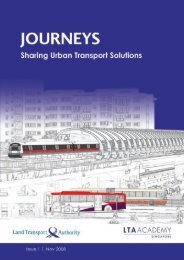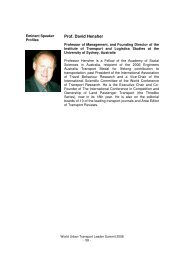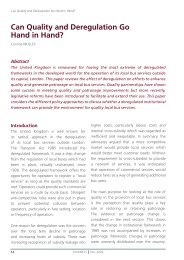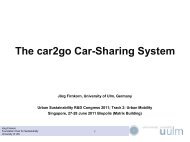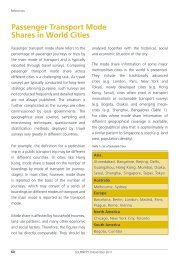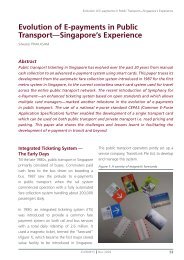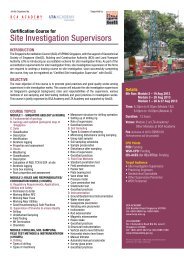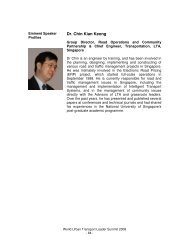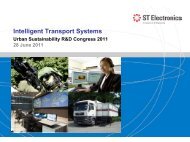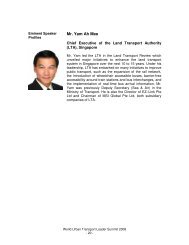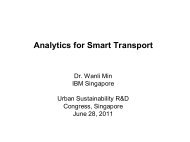Full Version - Issue 7 | November 2011 - LTA Academy
Full Version - Issue 7 | November 2011 - LTA Academy
Full Version - Issue 7 | November 2011 - LTA Academy
Create successful ePaper yourself
Turn your PDF publications into a flip-book with our unique Google optimized e-Paper software.
• The development of a brand for TMM in<br />
Abu Dhabi and an associated marketing<br />
programme;<br />
• Identification of the legislative and policy<br />
changes needed to support TMM;<br />
• Guidance on the incorporation of TMM in the<br />
development process;<br />
• The d e v e l o p m e n t of a short-term<br />
implementation programme and action plan;<br />
• The preparation of a TMM Toolkit that<br />
organisations can use in taking forward their<br />
own TMM plans; and<br />
• An overarching TMM strategy that sets out<br />
how the concept can be moved forward.<br />
This programme is the most ambitious<br />
application of TMM in the region. As it is also a<br />
relatively new concept, a number of challenges<br />
have arisen. A summary of the key issues that<br />
the TMM programme has needed to address is<br />
provided in Table 4.<br />
Table 4: Core Challenges for TMM in Abu Dhabi<br />
Transport Mobility Management: Small Changes - Big Impacts<br />
Critical Factors for Success<br />
Whilst TMM is still considered a relatively<br />
new element of the transport practitioner’s<br />
toolbox, the examples cited above are part of<br />
a growing evidence base of TMM approaches<br />
and applications across the world. The more<br />
successful TMM initiatives are those that are<br />
embedded in the wider transport approach of<br />
a government, authority or service provider.<br />
TMM is not a stand alone concept; it is a<br />
dynamic approach that can maximise the<br />
potential of new and existing infrastructure<br />
and policy (Table 5).<br />
Challenge Approach Taken to Address Challenge<br />
1. A lack of awareness of<br />
TMM<br />
2. The view that TMM is<br />
solely a European / USA<br />
concept<br />
3. The need to understand<br />
the potential Abu Dhabi<br />
specific benefits of TMM<br />
4. The need to quantify the<br />
potential benefits<br />
5. A lack of TMM skills<br />
and experience that<br />
are needed to ensure<br />
momentum is maintained<br />
An extensive stakeholder engagement programme to inform<br />
and secure buy-in<br />
The need to keep driving home the message that TMM is<br />
about delivering site specific / locally appropriate initiatives<br />
that meet the needs of local users.<br />
Close engagement with pilot organisation to assess the role<br />
that TMM can play and where the benefits lie. The key output<br />
was that TMM will play a useful role in the Corporate and<br />
Social Responsibility agenda.<br />
An impacts assessment undertaken to show the potential<br />
benefits. This, along with the use of international best<br />
practice examples helps to facilitate the roll out of the TMM<br />
programme.<br />
Whilst TMM is not an expensive initiative in comparison to<br />
new infrastructure projects, it is labour intensive. It requires<br />
ongoing input from those that understand TMM to upskill<br />
new individuals and organisations. This can be done quite<br />
quickly but cannot be ignored.<br />
JOURNEYS | <strong>November</strong> <strong>2011</strong><br />
TMM is not a stand alone concept;<br />
it is a dynamic approach that can<br />
maximise the potential of new and<br />
existing infrastructure and policy.<br />
27



